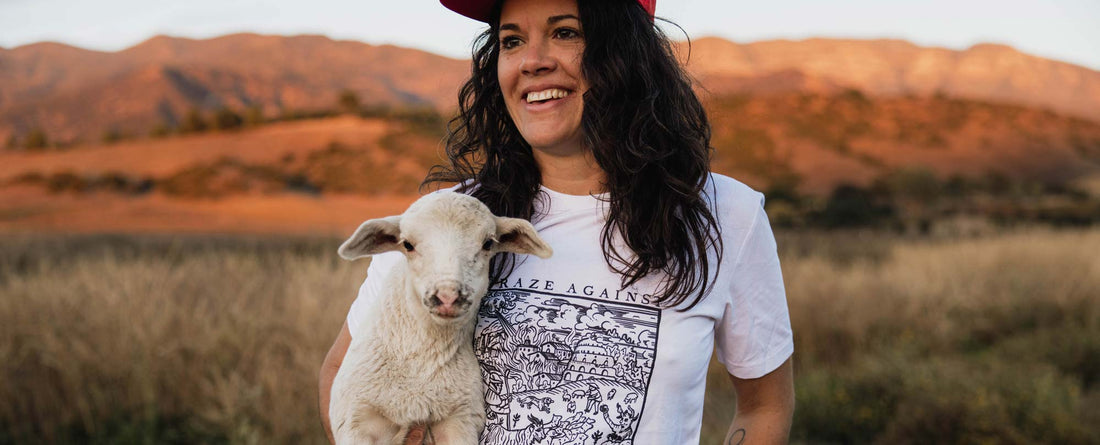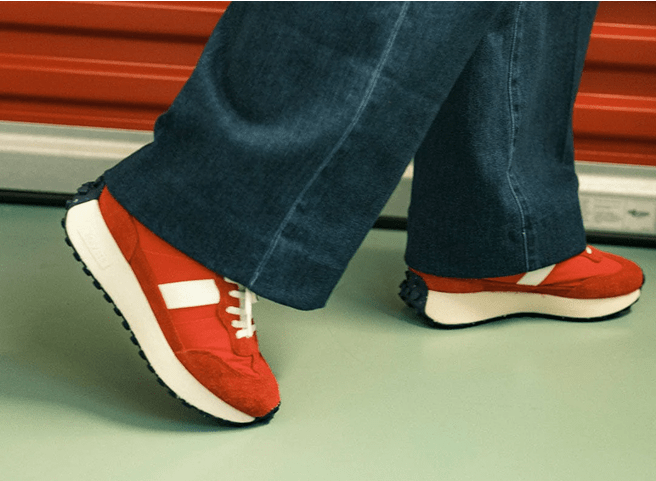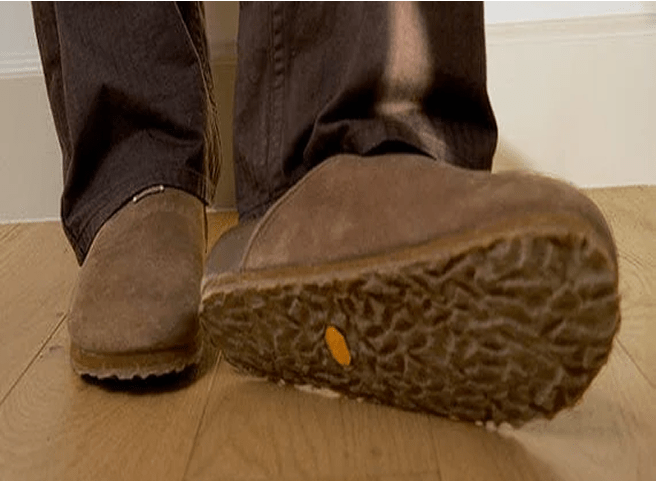Daydreamer Series: Taking the Indirect Route To Your Purpose
Shepherdess Cole Bush is passing down ancient knowledge to create modern opportunities.

Cole Bush’s pickup truck shutters to a halt in front of a small fenced-in pasture, a plume of dust billowing out from under the tires. “It’s zoomie time!” Cole laughs as she climbs out of the driver’s seat, watching a group of newborn lambs running at full speed through the field, kicking up clumps of dirt. The juveniles are the newest members of the herd of goats and sheep that make up Cole’s Shepherdess Land & Livestock Co, her contract grazing operation that helps with invasive species management, wildfire mitigation and enhancing the ecosystem across Southern California.
On the truck’s bumper reads the sticker “Graze Against the Machine,” which somehow perfectly encapsulates Cole herself: funny, rebellious, and here on a mission. The former aspiring stunt woman wants to preserve culture with her Grazing School of the West, passing on ancient knowledge and modern conservation techniques to create job opportunities for others. But before she could help others find purpose in pastoral pursuits, she had to take a few detours.
As told to SeaVees. Photography by Johnie Gall and Brandon Scherzberg.


“Growing up in San Diego looked like every teen movie. Everyone had their role to play and I think I recognized early on that fitting in felt like a performance in itself, and I just didn’t feel like playing any of the archetypes available to me. I was a naughty teenager [laughs], but I threw myself into work—I managed a cafe, which scratched my itch to be social. When you’re serving coffee, you get to meet all different types of humans and create these intimate relationships with your regulars. I just fell in love with people, which is why by the time I graduated high school, I had started to recognize there was an illness of individualism where I was raised.
“Fitting in felt like a performance and I just didn’t feel like playing any of the archetypes available to me.”
My family had business in Mexico, and we’d often drive down on weekends together. Across the border we’d share these big, classic Sunday dinners with the community, where food was abundant and everyone knew each other. It felt so vibrant and joyful, whereas back in the suburbs of San Diego, we all lived in these silly McMansions where we didn’t even know our neighbors’ names. And that’s not to demonize where I grew up—it was a very privileged and beautiful lifestyle—but I was left with this burning question: How do we preserve culture and community in a rapidly developing world?

I had to be real with myself: I wasn’t ready for college. I traveled to Tanzania, where I climbed Mount Kilimanjaro and visited with the Maasai people, who are a traditional pastoral culture—moving and living seasonally with their animals. I had my mom’s old 35mm Pentax film camera with me, and one day I snapped a photo of this Maasai man who was herding his goats, sheep and cattle on the side of the road. The moment the shutter went off, I just knew that animals were a part of something deeper within me, that maybe they were part of the answer to this question I’d been asking.
From there, I took a very winding academic route. I took city and community college courses, but it’s always been hard for me to learn in a system that teaches people in a very specific and structured way. I do funny things with how I read, scrambling up numbers and letters, a form of dyslexia. My stepmother and little sister moved to Mexico City around that time, so I took the opportunity to go and live there for a year, studying at the largest university in Latin America, where I discovered a love for ancient architecture and culture. That led to me developing my own major, “Sustainable Design and Community Development,” at U.C. Santa Cruz where I was eventually turned on to permaculture. That was a segway into a study called Holistic Management.
“The moment the shutter went off, this seed was planted and I just knew animals were part of something deeper within me.”
I began to learn about how large herds of ruminants have helped shape the evolution of our landscapes, primarily grasslands. I was like, ‘Wait, so ranching can do good for the world? Livestock can help our environment?’ Grasslands take up something like 30 percent of our planet’s landmass, but they can actually sequester more carbon from the atmosphere than forests! But they’ve been degrading and desertifying—put animals on them using these Holistic Management practices, and you’re able to help nurture the soil, bring fertility back to the land, increase biodiversity, et cetera.


Around that time, I happened to adopt a border collie named Becky who worked at a ranch where they were using livestock to graze the understory of old growth Redwood trees. The ranch hired me to photo document the impacts of the project, and I saw for myself how quickly the landscape transitioned over the course of a few seasons under their grazing plans. You could say my dog got me the job [laughs]. I was traveling from the city to the country, the country to the city, and not really making the connection until a friend’s dad, who was the director of the East Bay Regional Parks District, learned of what I was doing and told his son ‘Hey, we’ve been hiring goats and sheep for fire abatement since the 1989 fires, and we’ve got a contract coming up for bid.’ I took the idea to the ranch owner, we made a bid, and we got it.
I was 26 years old and now a project manager for a grazing operation overseeing 1,200 animals. I guess you could say I’ve never really had a fear of taking risks. All those fits and starts of me trying to do things that didn’t work out, that friction preventing me from moving forward in a straight line, they led me in a meandering way to richer and more fulfilling opportunities. Over and over again, when there have been doors in front of me, I’ve had too much curiosity to not see what’s on the other side. I’m really grateful I’ve been courageous—or crazy—enough to keep knocking until they open. And if they don’t open, well, I’ve got a machete so I’ll just charge through and clear the brush in my way [laughs].
“When there’s been doors in front of me, I’ve had too much curiosity not to see what’s on the other side. If they don’t open, well, I’ve got a machete so I’ll just charge through and clear the brush in my way.”
I wanted to branch out and start my own grazing operation, but when you’re 28 years old with a bunch of student debt, it’s pretty risky to start a capital-intensive business. I started posting about my life on Instagram, and so many people who didn’t have agriculture backgrounds started asking me how to get into my line of work. My next dream took shape: helping people learn to shepherd. I was supported by a nonprofit called Fibershed to travel to Spain and France and investigate different shepherding schools to come up with a way to teach shepherding to people back in the United States. But without their subsidized education and considering our general cost of living, I started to spin out—my hopes and dreams of starting a grazing school were shot. After some big attempts to acquire funding through grants, I was like, 'Enough is enough. I can’t just dedicate my whole life to altruism and not be able to sustain myself.'

I moved to LA and threw myself into training in stunt performance, with the intent to ride horses in shows and commercials, which pays pretty well. But I felt like I had abandoned a dream. I had given so much to start that grazing school. There had been so much hype around me and my identity was wrapped up in that work, yet I’d just fallen off the map. But what I didn’t know was that those years I spent ruminating on my idea were crucial to its success: I realized the only way to train a new generation of shepherds was through employment at my own grazing business. I’ve now trained dozens of people on work with animals and the environment, creating jobs and modeling a new way for this ancient practice of pastoralism to be done. Now that I’ve grown, I can refocus on the nonprofit activities of the Grazing School of the West in a more viable way.


One of the most rewarding projects I’ve spearheaded is a partnership with the Los Angeles Sheriff's Department to pilot a grazing program on the fire-prone lands surrounding the second largest detention center in LA County. Think about it— if a fire breaks out there, how are you going to move 8,000 inmates quickly? We worked with four incarcerated men last season who came out and shadowed our shepherds, learning what a day in the life looks and feels like. They were able to work with their bodies, be outside in nature, get real life vocational training, all while having a very humanizing experience. My goal is to build an accredited program that can be used in trade schools, community colleges, and detention centers around the state for workforce development in this growing field of managing the land while increasing public safety. By connecting people with this ancient practice, I’ve also found a way to help reignite and preserve culture.
You have to create your own constellations to follow, where every star is a personal hero you are moved by, someone who makes you believe that your dream is possible. Dig into their stories and learn from their failures as much as you do their successes. So many of my heroes are my mentors— don’t be afraid to reach out to your ‘stars.’
“Even when I felt like a failure or that I didn’t have any credibility, I showed up anyway. And that has made all the difference.”
Go to every single conference, attend every event, sign up for every newsletter in your field. One thing I never stopped doing was showing up, even during those years I was a shepherd without any animals of my own. Even when I felt like a failure or that I didn’t have any credibility, I showed up anyway. And that has made all the difference.”
Cole wears the Dirtbag Darling Boot in Cashew.


